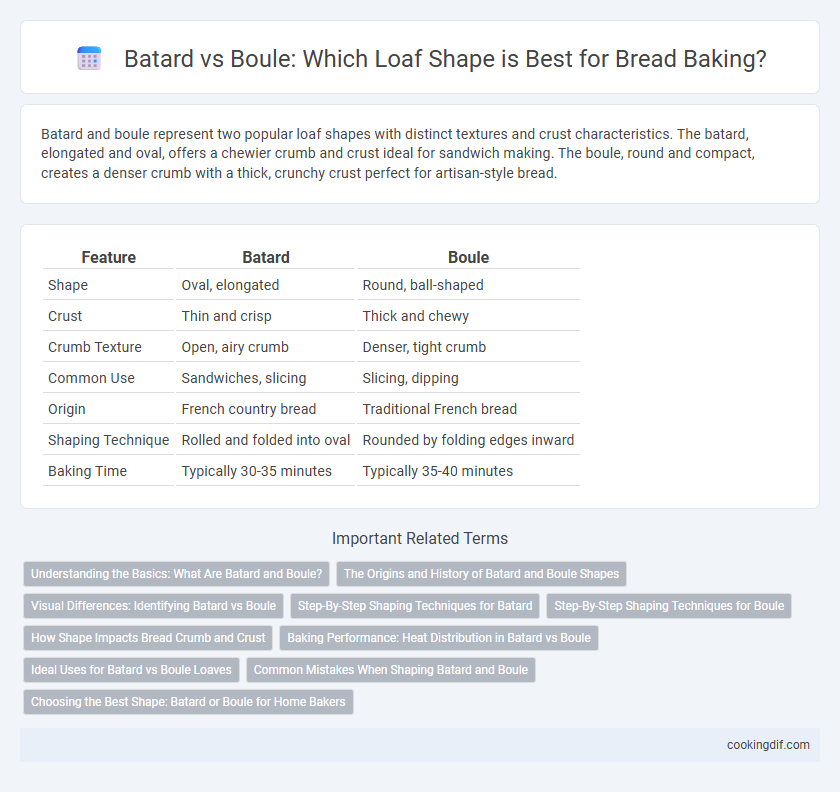Batard and boule represent two popular loaf shapes with distinct textures and crust characteristics. The batard, elongated and oval, offers a chewier crumb and crust ideal for sandwich making. The boule, round and compact, creates a denser crumb with a thick, crunchy crust perfect for artisan-style bread.
Table of Comparison
| Feature | Batard | Boule |
|---|---|---|
| Shape | Oval, elongated | Round, ball-shaped |
| Crust | Thin and crisp | Thick and chewy |
| Crumb Texture | Open, airy crumb | Denser, tight crumb |
| Common Use | Sandwiches, slicing | Slicing, dipping |
| Origin | French country bread | Traditional French bread |
| Shaping Technique | Rolled and folded into oval | Rounded by folding edges inward |
| Baking Time | Typically 30-35 minutes | Typically 35-40 minutes |
Understanding the Basics: What Are Batard and Boule?
Batard and boule are traditional French loaf shapes distinguished by their form and crumb structure, with batard being an elongated oval loaf and boule a round, ball-shaped bread. Batard offers a balanced crust-to-crumb ratio suitable for slicing, while boule features a thicker crust and a denser crumb ideal for tearing. Understanding these differences helps bakers select the perfect shape for texture, baking time, and presentation preferences.
The Origins and History of Batard and Boule Shapes
The batard loaf, originally French, emerged as a versatile shape combining elements of both round and elongated breads, tracing its roots to traditional European bakery techniques. The boule, a classic round loaf, has ancient origins dating back to medieval France, symbolizing rustic, artisanal bread making with a thick crust and soft crumb. Both shapes reflect centuries of baking evolution, influencing modern artisan bread by balancing functional shaping with cultural heritage.
Visual Differences: Identifying Batard vs Boule
Batard loaves feature an elongated oval shape with tapered ends, while boule loaves are distinctly round and symmetrical. The crust of a batard often displays a straighter score pattern along its length, contrasting with the boule's circular scoring that enhances its round form. Recognizing these visual cues helps distinguish between the batard's rustic, stretched look and the boule's classic, compact appearance.
Step-By-Step Shaping Techniques for Batard
Batard shaping involves folding the dough into a tight, elongated oval to create a uniform crumb and crust while maintaining an open structure. Begin by flattening the dough into a rectangle, folding the top third down and sealing the seam, then folding the bottom third up and pinching it closed. Roll the dough gently to elongate, tapering the ends slightly for that classic batard shape before final proofing.
Step-By-Step Shaping Techniques for Boule
To shape a boule, begin by flattening the dough into a rough circle, then fold the edges toward the center to create surface tension. Use your hands to rotate and tighten the dough on a lightly floured surface, creating a smooth, round shape. Finish by pinching the seams underneath to secure the loaf before proofing and baking.
How Shape Impacts Bread Crumb and Crust
The batard shape, being elongated and oval, produces a loaf with a higher crust-to-crumb ratio, resulting in a crispier crust and a slightly denser crumb due to the moderate dough height. In contrast, the boule's round form creates a thicker, chewier crust and a more open, airy crumb as the dough expands evenly in all directions during baking. These shape differences affect heat exposure and moisture retention, influencing the overall texture and baking characteristics of artisan breads.
Baking Performance: Heat Distribution in Batard vs Boule
Batard loaves feature an oval shape that provides more surface area for even heat distribution during baking, promoting a uniform crust and crumb structure. Boule loaves, with their round shape, concentrate heat towards the center, often resulting in a thicker crust and denser crumb. Heat distribution differences impact baking performance, influencing crust texture and overall loaf consistency between batard and boule shapes.
Ideal Uses for Batard vs Boule Loaves
Batard loaves, characterized by their elongated shape and thinner crust, are ideal for sandwiches and toast due to their uniform slicing and soft crumb. Boule loaves, with a round, rustic form and thicker crust, excel in artisan-style bread applications, perfect for dipping, tearing, and serving alongside soups or cheese. Choosing between batard and boule depends on the intended use, where batards favor structure and ease of slicing, while boules highlight texture and crustiness.
Common Mistakes When Shaping Batard and Boule
Common mistakes when shaping batard include uneven tension and improper folding, resulting in a dense crumb and misshapen loaf. Boule shaping errors often involve insufficient rounding and inconsistent seam sealing, causing flat or burst loaves during baking. Mastery of even tension and tight, smooth surface shaping improves both batard and boule structure and oven spring.
Choosing the Best Shape: Batard or Boule for Home Bakers
Batard and boule are popular loaf shapes with distinct characteristics that influence baking results. Batard features an elongated oval form that promotes even crumb structure and crust development, ideal for slicing and sandwich making. Boule's round shape concentrates heat evenly, resulting in a thick, crispy crust and a chewy interior, favored for artisan-style breads and rustic presentations.
Batard vs Boule for loaf shaping Infographic

 cookingdif.com
cookingdif.com